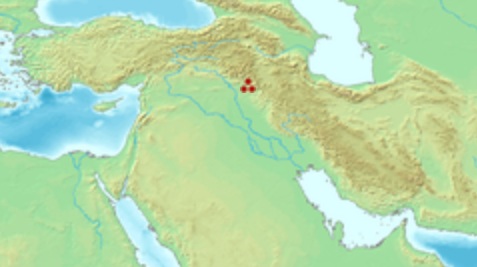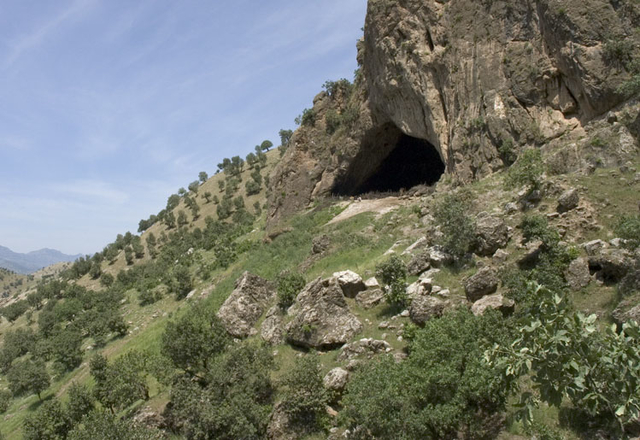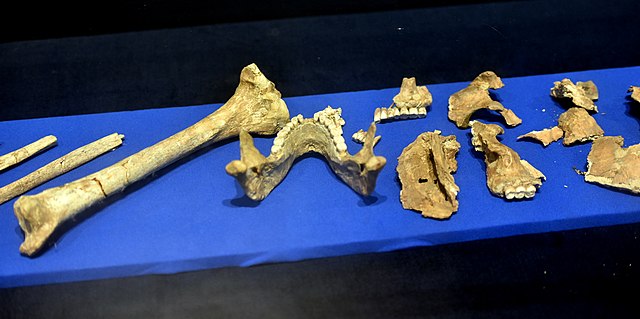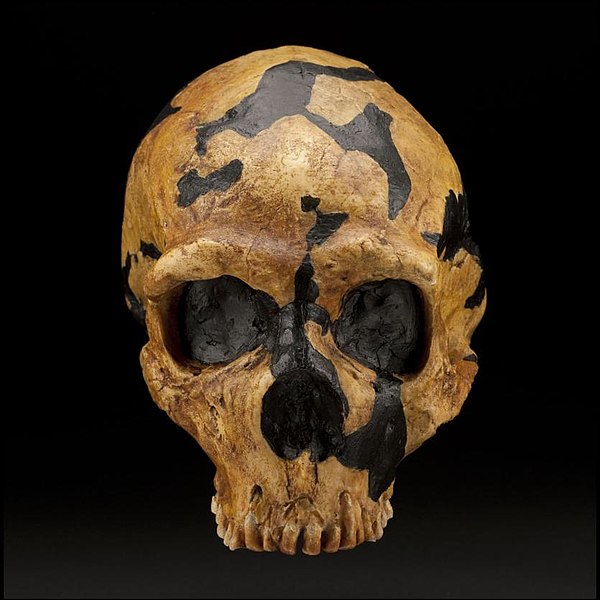
| SHANIDAR CAVE
Shanidar Cave in Iraq
The entrance to Shanidar Cave in Kurdistan Location : Erbil Governorate, Kurdistan Region, Iraq
Region : Zagros Mountains
Coordinates : 36.8006° N 44.2433° E
Shanidar Cave (Kurdish: Zewî Çemî Saneder) is an archaeological site located on Bradost Mountain in the Erbil Governorate of Kurdistan Region in northern Iraq. Anthropologist Ralph Solecki led a crew from Columbia University to explore the site beginning in 1951. With the accompaniment of Kurdish workers, the group excavated the Shanidar Cave and found the remains of eight adult and two infant Neanderthals, dating from around 65,000–35,000 years ago. These individuals were uncovered amongst a Mousterian layer accompanied by various stone tools and animal remains. The cave also contains two later proto-Neolithic cemeteries, one of which dates back about 10,600 years and contains 35 individuals, and is considered by Solecki to belong to the Natufian culture.
The best known of the Neanderthals at the site are Shanidar 1, who survived several injuries during his life, possibly due to care from others in his group, and Shanidar 4, the famed 'flower burial'. Until this discovery, Cro-Magnons, the earliest known H. sapiens in Europe, were the only individuals known for purposeful, ritualistic burials.
The site is located within the Zagros Mountains.
Neanderthal
remains :
The first nine (Shanidar 1–9) were unearthed between 1957 and 1961 by Ralph Solecki and a team from Columbia University. The skeleton of Shanidar 3 is held at the Smithsonian Institution. The others (Shanidar 1, 2, and 4–8) were kept in Iraq and may have been lost during the 2003 invasion, although casts remain at the Smithsonian. In 2006, while sorting a collection of faunal bones from the site at the Smithsonian, Melinda Zeder discovered leg and foot bones from a tenth Neanderthal, now known as Shanidar 10.
Shanidar 1 :
Shanidar I's skull and skeleton, c. 60,000 to 45,000 BCE. Iraq Museum Shanidar 1 was an elderly Neanderthal male known as ‘Nandy’ to his excavators. He was aged between 30 and 45 years, remarkably old for a Neanderthal. Shanidar 1 had a cranial capacity of 1,600 cm3, was around the height of 5 feet 7 inches, and displayed severe signs of deformity. He was one of four reasonably complete skeletons from the cave which displayed trauma-related abnormalities, which in his case would have been debilitating to the point of making day-to-day life painful.
During the course of the individual’s life, he had suffered a violent blow to the left side of his face, creating a crushing fracture to his left orbit which would have left him partially or totally blind in one eye. Research by Ján Lietava shows that the individual exhibits “atypically worn teeth”. Severe changes to the individuals incisors and a flattened capitulum show additional evidence towards Shanidar 1 suffering from a degenerative disease. Additionally, analysis shows that Shanidar 1 likely suffered from profound hearing loss, as his left ear canal was partially blocked and his right ear canal was completely blocked by exostoses. He also suffered from a withered right arm which had been fractured in several places. A fracture of the individual’s C5 vertebrae is thought to have caused damage to his muscle function (specifically the deltoids and biceps) of the right arm. Shanidar 1 healed, but this caused the loss of his lower arm and hand. This is thought to be either congenital, a result of childhood disease and trauma, or due to an amputation later in his life. The sharp point caused by a distal fracture of the individual's right humerus points towards this theory of amputation. If the arm was amputated, this demonstrates one of the earliest signs of surgery on a living individual. The arm had healed, but the injury may have caused some paralysis down his right side, leading to deformities in his lower legs and feet. Studies show that this individual had suffered from two broken legs. This would have resulted in him walking with a pronounced, painful limp. These findings in Shanidar 1’s skeleton propose that he was unlikely to be able to provide for himself in a Neanderthal society.
More recent analysis of Shanidar 1 by Washington University Professor Erik Trinkaus and Dr. Sébastien Villotte of the French National Centre for Scientific Research confirm that bony growths in his ear canals would have resulted in extensive hearing loss. These bony growths support a diagnosis of diffuse idiopathic skeletal hyperostosis (DISH), also known as Forestier's disease. This diagnosis would make Shanidar 1 the oldest hominin specimen clearly presenting this systemic condition. The researchers found these bone growths in multiple places all over the partial skeleton.
As a result of the healing of his injuries, Shanidar 1 lived a substantial amount of time before his death. If the Neanderthals did perform surgery on Shanidar 1, this proves that their methods were successful in sustaining life. Considering that all the injuries were healed during this time period may lead to the reasoning that this individual was kept alive for a reason. According to paleoanthropologist Erik Trinkaus, Shanidar must have been aided by others in order to survive his injuries. Due to all of the injuries and side effects of trauma, it was very unlikely that this individual could independently provide for his family implying he may have been kept alive due to a high status within society or a repository of cultural knowledge.
This evidence has led to speculation that the Neanderthals had some sort of altruistic characteristics with the possibility of the presence of ethos within the Neanderthal community. The discovery of stone tools found in proximity to these individuals allows us to deduce that the Neanderthals exhibited enough intelligence to make everyday life easier for themselves. Maybe this knowledge surpasses basic comprehension to include characteristics such as humility and compassion which have the most known presence in Homo sapiens. These individuals may have had the capacity to show empathy to others and come to the understanding that life has meaning - causing them to want to help Shanidar 1.
Shanidar 2 :
Skeletal remains of Shanidar II, c. 60,000 to 45,000 BCE. Iraq Museum Shanidar 2 was a Neanderthal male around the age of 30 who suffered from slight arthritis, found lying on his right side. It is estimated that Shanidar 2 was 5 feet 2 inches in stature which places him just below the average height of a male Neanderthal. He was killed by rocks falling from the cave’s ceiling, which crushed his skull and bones significantly. The skull had been compressed by about 5–6 cm. Much of his bones were missing when discovered, and the left tibia had teeth marks. Scavengers likely disposed of parts of his remains. There is evidence that Shanidar 2 was given a ritual send-off: a small pile of stones with some worked stone points (made out of chert) were found on top of his grave. Also, there had been a large fire by the burial site.
Shanidar 2 had a "higher cranial vault", and other skull proportions that did not quite match up to the average Neanderthal skull. This may prove that the Neanderthals of Shanidar had more of a "morphology of anatomically modern humans" than other Neanderthals, or that the group was very diverse. This points to similarities between the two species, Neanderthals and Homo sapiens, but it doesn’t show any inherit "relationships within that species".
Shanidar 3 :
Inside the Shanidar Cave Shanidar 3 was a 40- to 50-year-old male, found in the same grave as Shanidar 1 and 2. A wound to the left 9th rib suggests that the individual died of complications from a stab wound by a sharp implement. Bone growth around the wound indicates that Shanidar 3 lived for at least several weeks after the injury with the object still embedded. The angle of the wound rules out self-infliction, but is consistent with an accidental or purposeful stabbing by another individual. Recent research has suggested that the injury may have been caused by a long range projectile. This would be the earliest example of inter-personal or inter-specific violence in the human fossil record and the only such example amongst Neanderthals. The presence of early-modern humans, possibly armed with projectile weapons, in western Asia around the same time has been taken to imply that this injury may have resulted from inter-species conflict. However, spears produced by Neanderthals 300,000-400,000 years BP were likely used as projectiles. Shanidar 3 also suffered from a degenerative joint disorder in his foot resulting from a fracture or sprain, which would have resulted in painful, limited movement. The skeleton is on display at the Hall of Human Origins at the National Museum of Natural History in Washington, D.C.
Shanidar 4, the "flower burial" :
Shanidar Neanderthal skull, dated to 80,000 – 60,000 BP The skeleton of Shanidar 4, an adult male aged 30–45 years, was discovered by Solecki in 1960, positioned on his left side in a partial fetal position.
For many years, Shanidar 4 was thought to provide strong evidence for a Neanderthal burial ritual. Routine soil samples from around the body, gathered for pollen analysis in an attempt to reconstruct the palaeoclimate and vegetational history of the site, were analysed eight years after its discovery. In two of the soil samples in particular, whole clumps of pollen were discovered by Arlette Leroi-Gourhan in addition to the usual pollen found throughout the site, suggesting that entire flowering plants (or at least heads of plants) had been part of the grave deposit.
Furthermore, a study of the particular flower types suggested that the flowers may have been chosen for their specific medicinal properties. Yarrow, cornflower, bachelor's button, St Barnaby's thistle, ragwort, grape hyacinth, horsetail and hollyhock were represented in the pollen samples, all of which have been traditionally used, as diuretics, stimulants, and astringents and anti-inflammatories. This led to the idea that the man could possibly have had shamanic powers, perhaps acting as medicine man to the Shanidar Neanderthals.
However, recent work has suggested that the pollen was perhaps introduced to the burial by animal action, as several burrows of a gerbil-like rodent known as the Persian jird were found nearby. The jird is known to store large numbers of seeds and flowers at certain points in their burrows and this argument was used in conjunction with the lack of ritual treatment of the rest of the skeletons in the cave to suggest that the Shanidar 4 burial had natural, not cultural, origins. Paul B. Pettitt has stated that the "deliberate placement of flowers has now been convincingly eliminated", noting that "A recent examination of the microfauna from the strata into which the grave was cut suggests that the pollen was deposited by the burrowing rodent Meriones persicus, which is common in the Shanidar microfauna and whose burrowing activity can be observed today". Despite his conclusions that flowers were unlikely to have been deliberately placed, Petitt nevertheless concludes that the Shanidar burials, because they happened over so many years, represent a deliberate mortuary practice by Neanderthals.
Shanidar
Z :
Source :
https://en.wikipedia.org/ |





